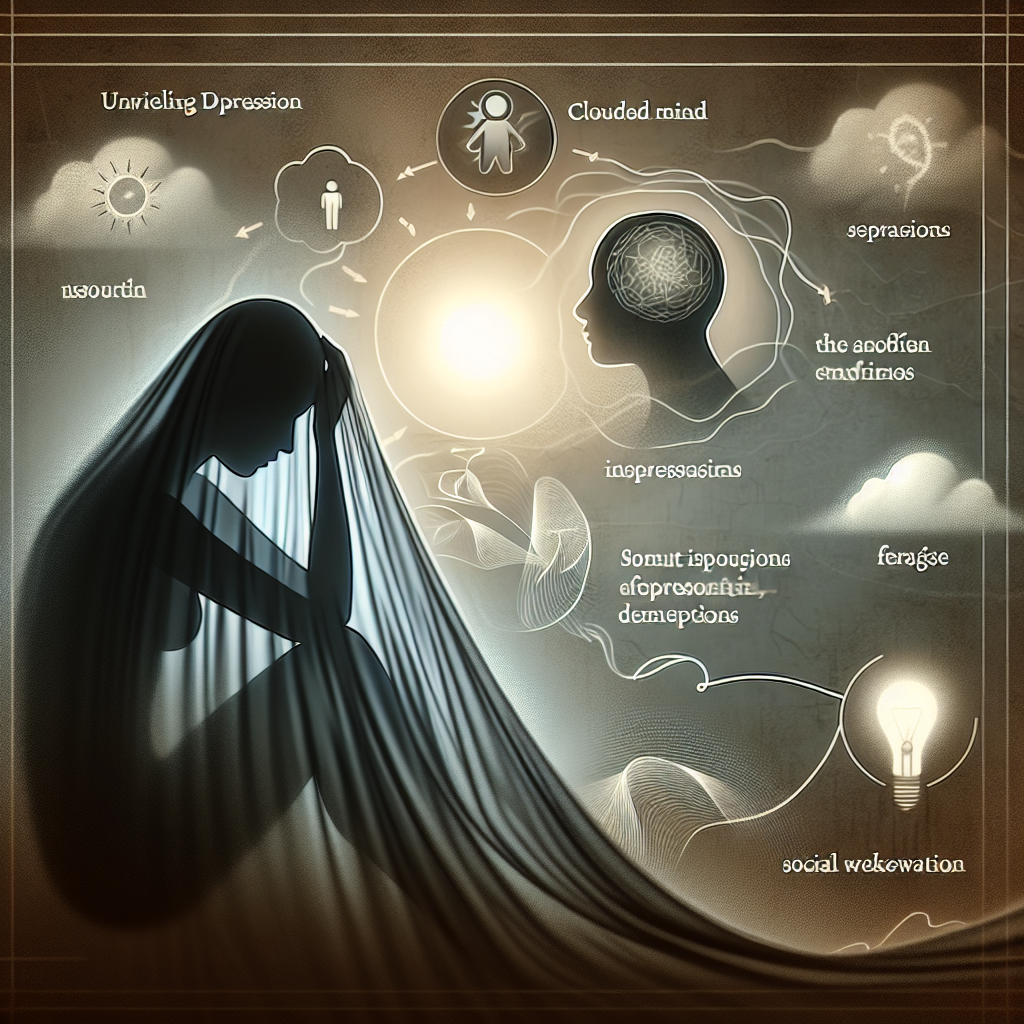
Unveiling Depression: A Look at Its Most Prevalent Symptoms – The Ultimate Guide to Understanding and Overcoming It
Introduction: Shedding Light on a Silent Struggle
Depression is often termed a silent killer. It lurks beneath the surface, affecting millions while remaining largely undetected or misunderstood. As we embark on this journey of Unveiling Depression: A Look at Its Most Prevalent Symptoms, you may find yourself or a loved one resonating with its profound impact on daily life. Recognizing these symptoms is the first step toward healing, and understanding them can pave the way for recovery and hope.
Mental health has never been more critical. As societal stigma gradually diminishes, awareness about the complexity of depression grows, urging us to seek clarity and compassion. In this article, we will delve deep into the pervasive symptoms of depression, supported by real-life case studies, relevant data, and actionable insights, ensuring that our exploration is both enlightening and empowering.
Understanding Depression: The Basics
What is Depression?
Depression is more than just feeling sad or down; it is a pervasive mood disorder that affects emotions, thoughts, and daily activities. According to the World Health Organization (WHO), over 264 million people around the globe are affected by depression. It may manifest differently across individuals, which is why Unveiling Depression: A Look at Its Most Prevalent Symptoms is essential for proper identification and treatment.
Common Misconceptions
- "It’s just a phase." Many people dismiss depression as a temporary feeling, but it often requires professional intervention.
- "Only adults can be depressed." Depression can affect anyone, regardless of age, including children and teenagers.
- "It’s a weakness." Depression is a complex mental illness, not a character flaw or sign of weakness.
The Most Prevalent Symptoms of Depression
Understanding the symptoms of depression is crucial for personal awareness and familial support. Below, we outline some of the most common, yet often overlooked, indicators.
1. Persistent Sadness or Low Mood
- Description: A continuous feeling of sadness, emptiness, or hopelessness.
- Analysis: This symptom often resonates with many individuals suffering from depression. It can last for weeks or even months, which can significantly impair daily functioning.
2. Loss of Interest or Pleasure
- Description: A marked decrease in interest or pleasure in previously enjoyed activities.
- Case Study: Sarah, a once-passionate singer, found herself losing interest in her music after experiencing a traumatic event. She stopped attending rehearsals altogether, highlighting how depression can strip away joy.
3. Changes in Appetite or Weight
- Description: Noticeable weight gain or loss, or significant changes in appetite.
- Data Insight: Research shows that 30% of individuals suffering from depression experience changes in appetite. This symptom can contribute to a cycle of low self-esteem and further depressive symptoms.
4. Sleep Disturbances
- Description: Insomnia or hypersomnia is a common symptom.
- Table: Common Sleep Patterns in Depression
| Type of Sleep Disruption | Description |
|---|---|
| Insomnia | Difficulty falling or staying asleep |
| Hypersomnia | Excessive sleeping |
- Impact: Sleep quality directly influences mood; disruptions can exacerbate depressive symptoms.
5. Fatigue or Loss of Energy
- Description: Feeling fatigued or having a diminished capacity to perform regular tasks.
- Analysis: James, a 35-year-old executive, reported feeling exhausted after minimal effort. This fatigue often leads to decreased productivity and can fuel feelings of inadequacy.
6. Difficulty Concentrating
- Description: Struggling to focus or make decisions.
- Insight: Chloe, a college student, mentioned that maintaining her GPA became increasingly challenging due to her inability to concentrate, which affected her academic performance.
7. Feelings of Worthlessness or Guilt
- Description: Overwhelming feelings of self-criticism and guilt over minor issues.
- Statistics: According to a study, 40% of individuals with depression report pervasive feelings of worthlessness.
8. Suicidal Ideation
- Description: Thoughts of self-harm or suicide.
- Insight and Importance: It is crucial to take this symptom seriously. Oliver, a 22-year-old, sought therapy after expressing suicidal thoughts, emphasizing the importance of timely intervention.
The Emotional Toll: How Symptoms Interconnect
When examining the symptoms of depression, it’s essential to appreciate how they interact and compound one another. For example:
- A lack of sleep can lead to fatigue, which can, in turn, worsen a person’s mood.
- Feelings of worthlessness may inhibit one’s drive to engage in activities, leading to further isolation and sadness.
Case Study Analysis: Understanding the Whole Picture
Case Study: Emily’s Journey
Emily, a 30-year-old mother of two, experienced several of the symptoms outlined. Initially dismissing her persistent sadness as "just motherhood," she later sought help after her inability to bond with her children affected family dynamics. Recognizing the interconnectedness of her symptoms led her to therapy, emphasizing the importance of holistic understanding in treating depression.
Unveiling Depression: Seeking Help and Recovery
Professional Treatment Options
1. Psychotherapy
- Cognitive Behavioral Therapy (CBT): A structured treatment that helps reframe negative thought patterns.
- Interpersonal Therapy (IPT): Focuses on improving relationships and social functioning.
2. Medication
- Antidepressants: Such as SSRIs (Selective Serotonin Reuptake Inhibitors) can be effective for many individuals.
- Consultation Required: Professional evaluation is essential for medication management.
Self-Care Strategies
- Physical Activity: Regular exercise can significantly improve mood.
- Mindfulness and Relaxation Techniques: Practices like yoga or meditation can alleviate symptoms.
- Building a Support Network: Connecting with friends or support groups can provide comfort and lessen feelings of isolation.
Conclusion: Embracing Hope in the Face of Adversity
Through Unveiling Depression: A Look at Its Most Prevalent Symptoms, we have explored the emotional and psychological landscape of this complex mental illness. The road to recovery is often challenging, yet knowledge is a powerful ally. By recognizing and addressing these symptoms, we can foster greater understanding, compassion, and healing.
Let this guide serve not just as an educational resource, but as a beacon of hope for those struggling with depression, reminding each of us that help is available, and healing is possible.
FAQs Section
1. What are the early signs of depression?
Early signs include persistent sadness, loss of interest in activities, and changes in appetite or sleep. It’s important to recognize these symptoms and seek help early.
2. Can depression be cured?
While depression can often be managed effectively, complete "cure" may vary from person to person. Continuous self-care and therapy can lead to significant improvements.
3. Is medication necessary for everyone with depression?
Not everyone requires medication. Many individuals find relief through therapy and lifestyle changes. Consulting with a mental health professional is critical.
4. How can I support someone with depression?
Listening without judgment, encouraging professional help, and offering to accompany them to appointments can make a significant impact.
5. Are there lifestyle changes that can help alleviate depression symptoms?
Yes, regular exercise, a balanced diet, proper sleep, and mindfulness practices can greatly improve mental health and reduce symptoms.
This comprehensive exploration of Unveiling Depression: A Look at Its Most Prevalent Symptoms aims to provide both understanding and actionable insights, ensuring readers are equipped with the knowledge needed to navigate the challenges of depression.
















